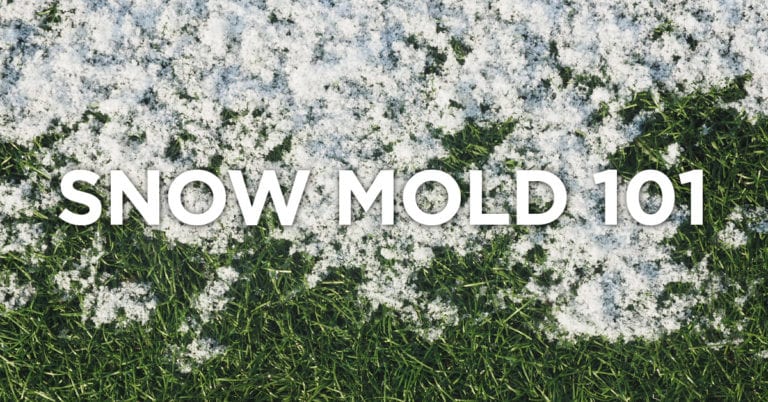Did you know: wet, snowy weather can leave a lasting impact on your lawn when the spring returns. Have you ever heard of snow mold? Lawn Pride is here to explain the disease, how to prevent it, and how to treat the problem in your Central Indiana lawn.

The Types
Pink Snow Mold
Pink snow mold forms under wet snow and affects all cool-season turfgrasses. This type of snow mold can be the most damaging to short-cut grass (maintained at 3 inches), juvenile grasses (1 year or younger), and golf courses. For more information on Pink Snow Mold, reference the Purdue Extension Turfgrass Disease Profiles.
Before the winter comes, pink snow mold survives through summer as spores in plant debris. This stuff can also continue to live and grow in fall and spring, whenever the weather remains cool and wet. Once winter arrives, pink snow mold grows under snow when the ground is not frozen. Subzero temperatures can kill it, but pink snow mold is resilient enough to survive even if the thermometer reads a degree or two below 32 if the grass beneath is still wet and cool.
Gray Snow Mold
Gray snow mold enjoys growing where there is consistent snow cover for long periods of time. This type of snow mold is similar to the pink stuff but differs in a few distinct ways. Gray snow mold can be found in infected plants or soil during summer, surviving in tiny, hard fungal shells known as “sclerotia.” This disease can reach the crown and cause more intense, lasting damage to the grass plant. Although the pink variety can tolerate temps up to about 60 degrees, gray snow mold activity turns off at about 45 degrees, or when the ground dries out. For more information on Gray Snow Mold, reference the Purdue Extension Turfgrass Disease Profiles.
The Symptoms
Warning signs of snow mold are easy to spot once the snow is gone. Look for straw-colored patches of grass, kind of like a dog urine stain on your lawn. As long as the grass is cold and wet, these circular patches will continue to expand. Gray snow mold appears as a white or gray in color, while pink snow mold may be white, pink, or tan. Sometimes, mushrooms will sprout out of these patches. Click here for more details on possible snow mold symptoms in your lawn.
The Treatment & Prevention
Although snow mold looks bad, thankfully it’s more of an aesthetic issue than a lawn health problem. If you discover telltale patches in early spring, gently raking affected areas can help them to dry out faster. Continue mowing your grass as you normally would, even over the patches since taller grass blades can promote further fungal growth.
Before winter even arrives, you can help prevent snow mold by raking and removing leaves and other vegetative debris in the fall. Keep up with recommended mowing schedules, even in autumn. Avoid late season fertilizers that have high nitrogen content. And when it does snow outside, control drifts and large piles by manually spreading out the snow. This will help it melt faster and prevent snow mold from taking root below the cover.
For more essential lawn care tips and tricks, turn to your local pros at Lawn Pride. Check out our winter lawn survival guide for more advice on keeping a healthy lawn throughout the winter. Contact us today for more lawn questions and concerns, and don’t forget to sign up for your 2018 program!
[/et_pb_text][/et_pb_column][/et_pb_row][/et_pb_section]